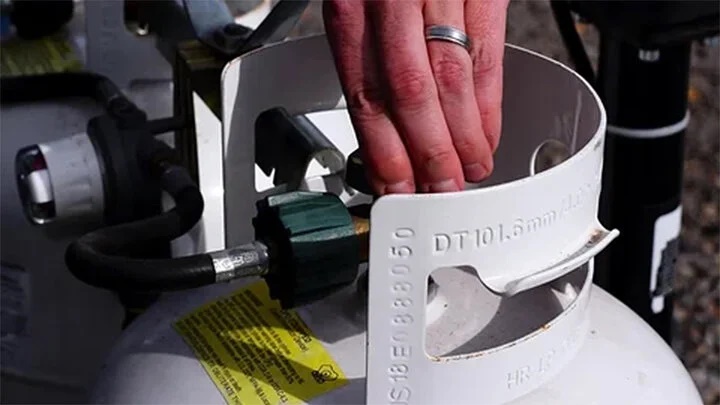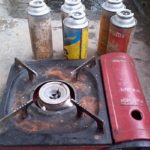Locking the gas valve after use is one of the safety principles that anyone cooking with a gas stove must remember. This is also recommended by gas stove repair technicians or gas stove sellers, reminding customers regularly. However, whether to lock the gas valve before or after turning off the stove is what many people are confused about.
Should the gas valve be locked before or after turning off the stove?
The answer is that you should lock the gas cylinder valve first before turning off the stove. The reason is that when you cook, gas will move from the cylinder through the pipe, hose, and to the burner of the stove. After the gas in the cylinder has been securely locked, a certain amount of excess gas will still exist in the supply line. This is the gas that has left the cylinder, entered the supply line but has not been converted into combustion gas. If gas remains in the supply line and hose, under suitable conditions, it can cause explosion.

Should the gas valve be locked before or after turning off the gas stove? The answer is to lock the valve first. (Photo: Toplist)
Therefore, to ensure safety when using a gas stove, the correct procedure is to lock the gas cylinder valve after cooking, wait until the flame on the stove is completely extinguished before turning off the stove. This way, you ensure that any excess gas in the line is consumed, preventing leakage, and keeping the stove from suddenly igniting when you turn it on again for cooking.
Safety principles when using a gas stove
According to Vnexpress, Nguyen Quang Tung, an expert in liquefied gas in Ho Chi Minh City, stated some safety principles when using a gas stove as follows:
– Place the gas cylinder in a well-ventilated area: Gas is usually heavier than air, so it will sink to the ground when released. Therefore, the space below the kitchen cabinets where the gas cylinder is placed should be well-ventilated. The gas cylinder must be placed at a distance of 1 to 1.5 meters from the stove. Even if the house is narrow, you should not place the gas cylinder right under the stove. The gas cylinder storage cabinet must always be open or completely removed for easy observation, avoiding mice building nests or chewing on the supply line.
– Buy gas cylinders from reputable companies, dealers, and avoid counterfeit products. A new gas cylinder must be filled with the correct weight as marked on the cylinder, not exceeding or being less than 0.1kg. When observing with the naked eye, the gas cylinder must be intact, without scratches, rust, or dents.
– The stove stand should be made of non-flammable materials. The stove should be placed at least 15 cm away from the wall, 1 to 1.5 m away from the ceiling, and 1.5 m away from electrical appliances. Do not place anything on the gas supply line, including the stove’s legs.
– After cooking, you should lock the valve at the gas cylinder to let the gas in the supply line burn completely before turning off the stove. Some people have a habit of turning off the stove after cooking without locking the cylinder, which is very dangerous. In fact, there have been many cases where the gas cylinder has not been locked, so gas has always leaked in the hose. When the hose is bitten by mice, the gas leaks out, causing poisoning or fire.
– Regularly clean the stove and gas appliances. If the old stove is rusty and of poor quality, you should replace it immediately. Gas explosions often occur due to gas leaking from a pierced cylinder, an open valve, or a bitten hose… Especially, the gas supply line is a “sensitive” component that is susceptible to leakage, so it should be replaced after 3 to 5 years of use.
– Regularly check gas appliances by using soapy water to apply on the gas cylinder, valve, and supply line. If you see any abnormal bubbles, there may be a leak.
– Gas is colorless, odorless, and tasteless, but the manufacturer adds a foul odor to easily detect leaks. When smelling this distinctive odor, especially at night, people often have a habit of turning on the lights or using a lighter to check the gas cylinder. This is quite dangerous because gas is highly flammable, and turning on lights, fans, or mobile phones can produce sparks that can ignite if they encounter gas. The correct way to deal with this situation is to open doors for ventilation to allow the gas to dissipate, reducing the gas concentration in the kitchen. If the odor becomes stronger, you should notify the gas dealer for immediate advice.
– If possible, you should install a small gas leak alarm device in the kitchen cabinet close to the gas cylinder and accessories, about 25cm away from the floor. The price of this device ranges from 200,000 to 400,000 VND per unit.
In the event of a fire, you should stay calm and follow these steps:
– Turn off the gas immediately.
– If there is no fire extinguisher, use a thick cloth or a wet blanket to smother the flames.
– If the fire is not under control and continues to spread, call 114 to summon the firefighting forces for timely rescue.
According to VTC news
Ensuring Safe Use of Mini Gas Stove With Encouraged Safety Precautions
Despite their popularity, there are potential safety risks associated with travel gas stoves that cannot be overlooked. A report released by safety experts has highlighted the potential for serious danger that these devices may pose.
gas cylinder in the stove?’>How to correctly place a gas cylinder in the stove?
Knowing how to properly handle and place a gas canister is essential for safety and to avoid any potential risks. It is important to follow the guidelines and regulations set forth to ensure the well-being of oneself and others. Understanding the proper procedures and precautions can make all the difference in preventing accidents and emergencies. Therefore, it is crucial for everyone to educate themselves on the correct techniques and best practices when dealing with gas canisters.
































